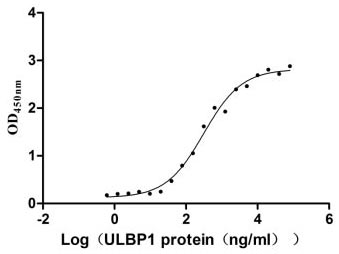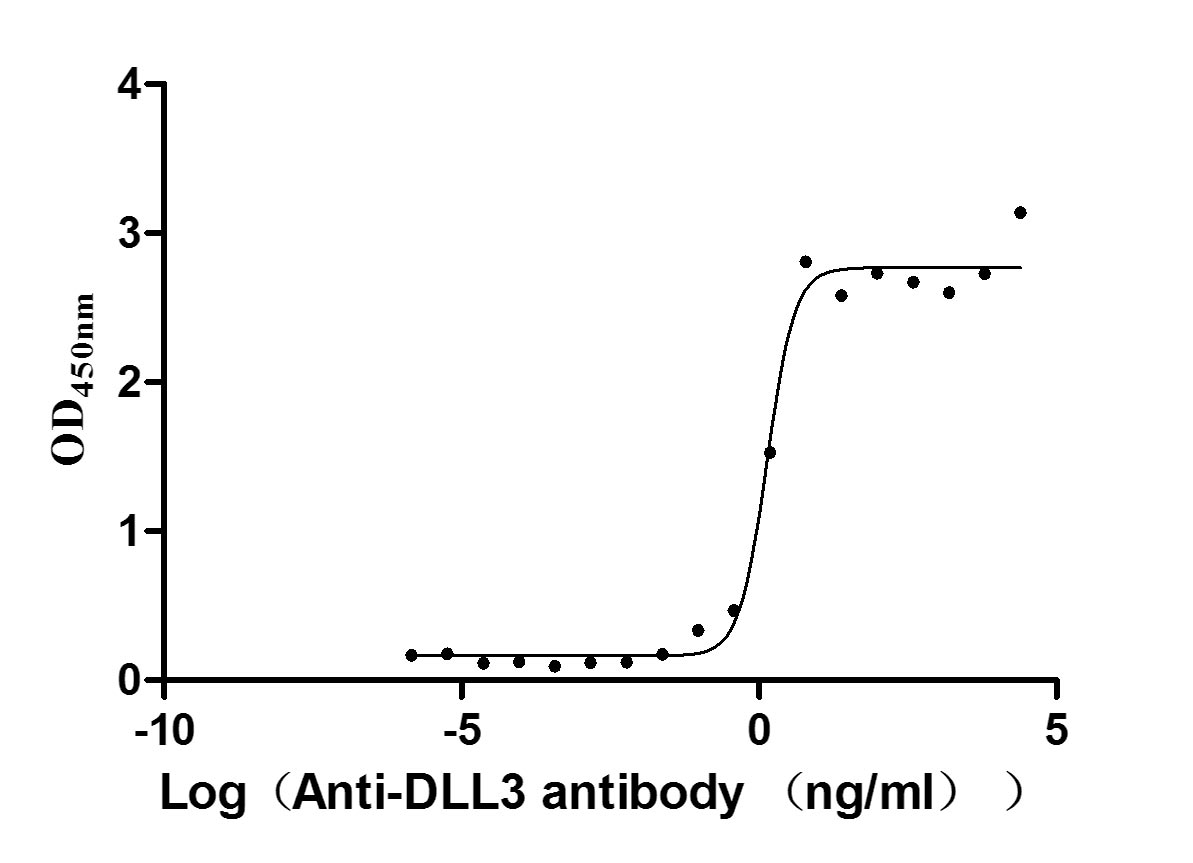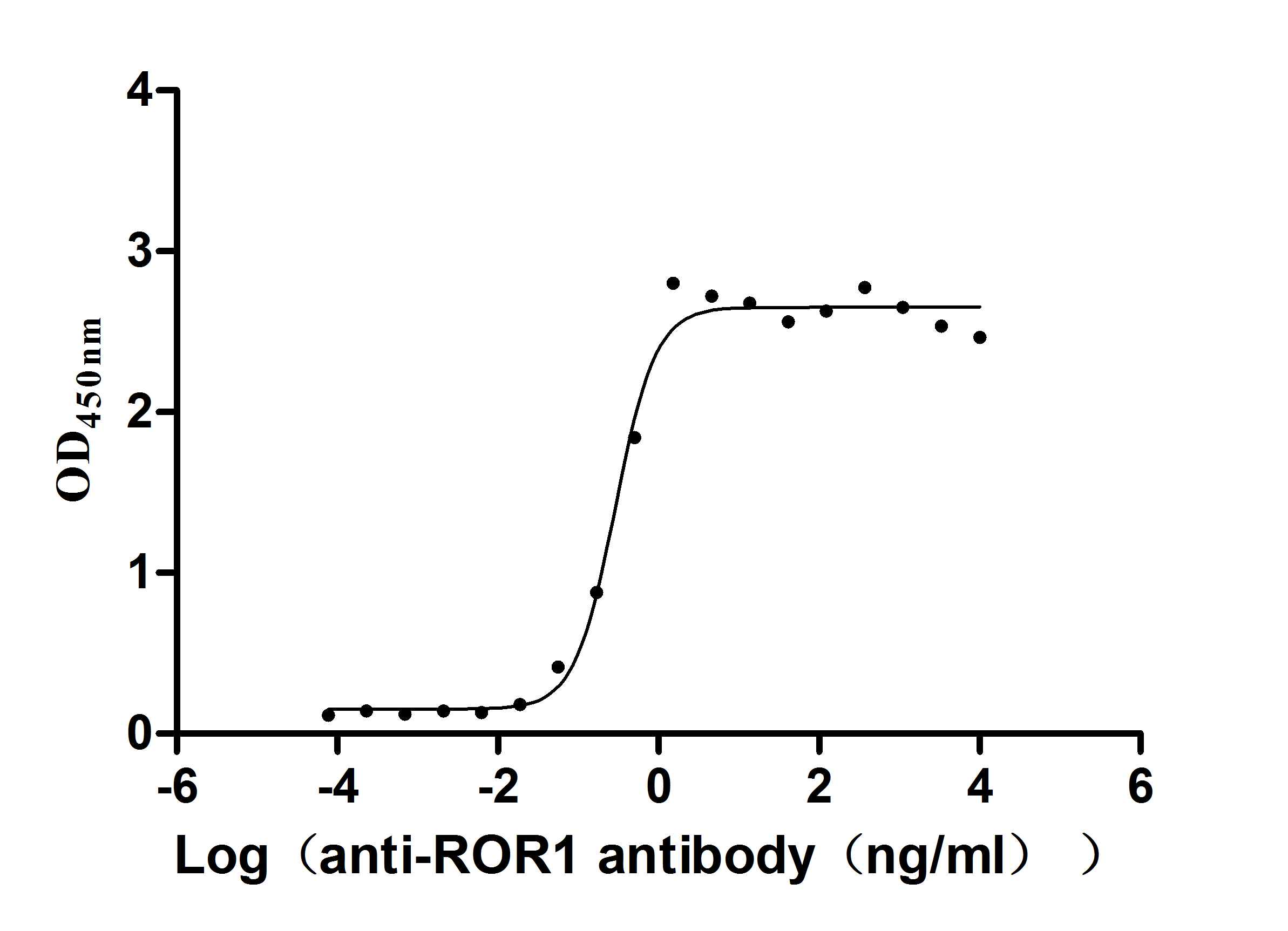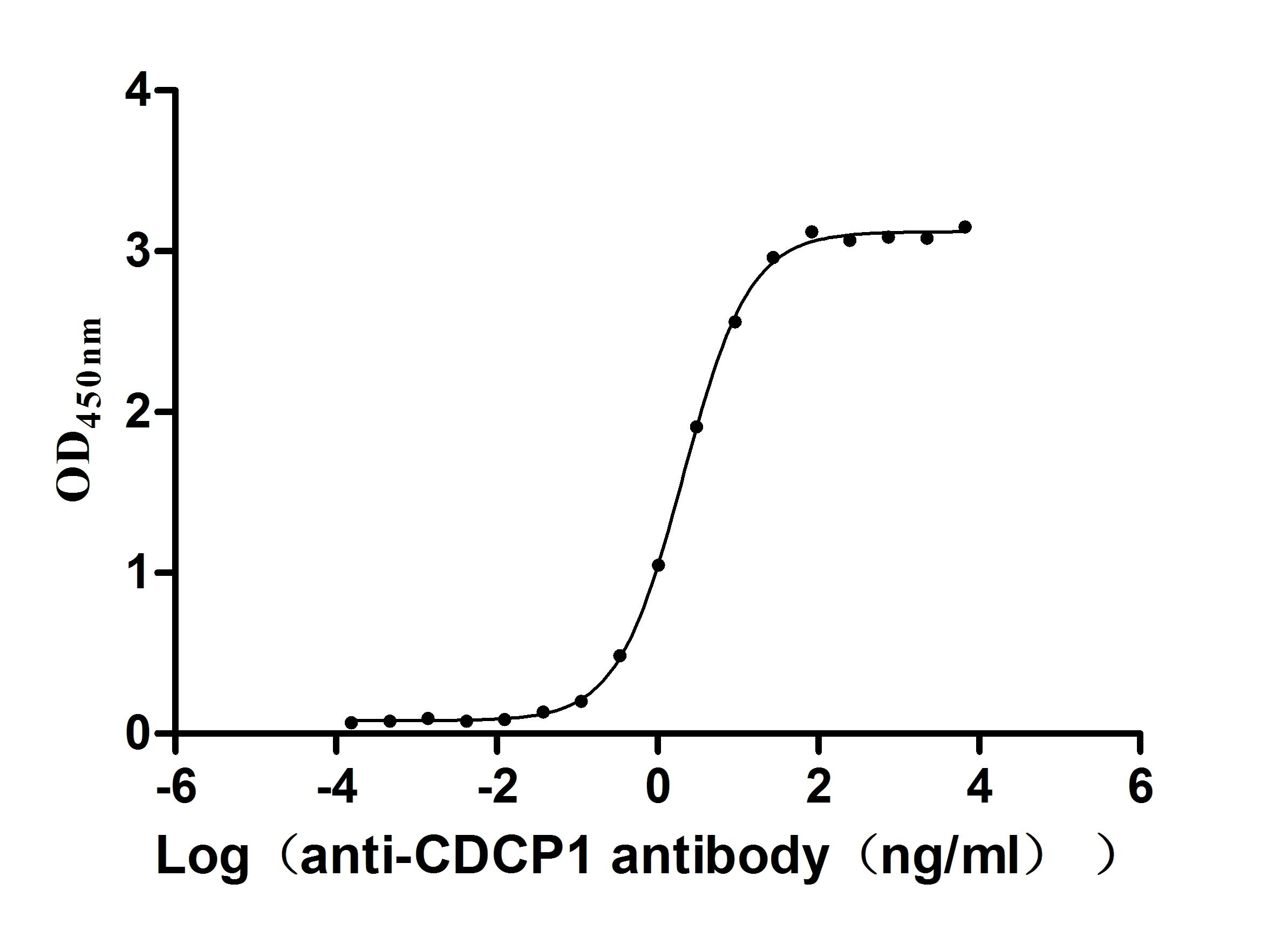Recombinant Human Cyclin-dependent kinase 9 (CDK9)
-
货号:CSB-YP005079HU
-
规格:
-
来源:Yeast
-
其他:
-
货号:CSB-EP005079HU
-
规格:
-
来源:E.coli
-
其他:
-
货号:CSB-EP005079HU-B
-
规格:
-
来源:E.coli
-
共轭:Avi-tag Biotinylated
E. coli biotin ligase (BirA) is highly specific in covalently attaching biotin to the 15 amino acid AviTag peptide. This recombinant protein was biotinylated in vivo by AviTag-BirA technology, which method is BriA catalyzes amide linkage between the biotin and the specific lysine of the AviTag.
-
其他:
-
货号:CSB-BP005079HU
-
规格:
-
来源:Baculovirus
-
其他:
-
货号:CSB-MP005079HU
-
规格:
-
来源:Mammalian cell
-
其他:
产品详情
-
纯度:>85% (SDS-PAGE)
-
基因名:CDK9
-
Uniprot No.:
-
别名:C-2K; CDC2 related kinase; CDC2L4; Cdk 9; Cdk9; CDK9_HUMAN; Cell division cycle 2-like protein kinase 4; Cell division protein kinase 9; CTK1; Cyclin dependent kinase 9; Cyclin-dependent kinase 9; PITALRE; Serine/threonine-protein kinase PITALRE; TAK; Tat associated kinase complex catalytic subunit
-
种属:Homo sapiens (Human)
-
蛋白长度:Full length protein
-
表达区域:1-372
-
氨基酸序列MAKQYDSVEC PFCDEVSKYE KLAKIGQGTF GEVFKARHRK TGQKVALKKV LMENEKEGFP ITALREIKIL QLLKHENVVN LIEICRTKAS PYNRCKGSIY LVFDFCEHDL AGLLSNVLVK FTLSEIKRVM QMLLNGLYYI HRNKILHRDM KAANVLITRD GVLKLADFGL ARAFSLAKNS QPNRYTNRVV TLWYRPPELL LGERDYGPPI DLWGAGCIMA EMWTRSPIMQ GNTEQHQLAL ISQLCGSITP EVWPNVDNYE LYEKLELVKG QKRKVKDRLK AYVRDPYALD LIDKLLVLDP AQRIDSDDAL NHDFFWSDPM PSDLKGMLST HLTSMFEYLA PPRRKGSQIT QQSTNQSRNP ATTNQTEFER VF
-
蛋白标签:Tag type will be determined during the manufacturing process.
The tag type will be determined during production process. If you have specified tag type, please tell us and we will develop the specified tag preferentially. -
产品提供形式:Lyophilized powder
Note: We will preferentially ship the format that we have in stock, however, if you have any special requirement for the format, please remark your requirement when placing the order, we will prepare according to your demand. -
复溶:We recommend that this vial be briefly centrifuged prior to opening to bring the contents to the bottom. Please reconstitute protein in deionized sterile water to a concentration of 0.1-1.0 mg/mL.We recommend to add 5-50% of glycerol (final concentration) and aliquot for long-term storage at -20℃/-80℃. Our default final concentration of glycerol is 50%. Customers could use it as reference.
-
储存条件:Store at -20°C/-80°C upon receipt, aliquoting is necessary for mutiple use. Avoid repeated freeze-thaw cycles.
-
保质期:The shelf life is related to many factors, storage state, buffer ingredients, storage temperature and the stability of the protein itself.
Generally, the shelf life of liquid form is 6 months at -20°C/-80°C. The shelf life of lyophilized form is 12 months at -20°C/-80°C. -
货期:Delivery time may differ from different purchasing way or location, please kindly consult your local distributors for specific delivery time.Note: All of our proteins are default shipped with normal blue ice packs, if you request to ship with dry ice, please communicate with us in advance and extra fees will be charged.
-
注意事项:Repeated freezing and thawing is not recommended. Store working aliquots at 4°C for up to one week.
-
Datasheet :Please contact us to get it.
相关产品
靶点详情
-
功能:Protein kinase involved in the regulation of transcription. Member of the cyclin-dependent kinase pair (CDK9/cyclin-T) complex, also called positive transcription elongation factor b (P-TEFb), which facilitates the transition from abortive to productive elongation by phosphorylating the CTD (C-terminal domain) of the large subunit of RNA polymerase II (RNAP II) POLR2A, SUPT5H and RDBP. This complex is inactive when in the 7SK snRNP complex form. Phosphorylates EP300, MYOD1, RPB1/POLR2A and AR and the negative elongation factors DSIF and NELF. Regulates cytokine inducible transcription networks by facilitating promoter recognition of target transcription factors (e.g. TNF-inducible RELA/p65 activation and IL-6-inducible STAT3 signaling). Promotes RNA synthesis in genetic programs for cell growth, differentiation and viral pathogenesis. P-TEFb is also involved in cotranscriptional histone modification, mRNA processing and mRNA export. Modulates a complex network of chromatin modifications including histone H2B monoubiquitination (H2Bub1), H3 lysine 4 trimethylation (H3K4me3) and H3K36me3; integrates phosphorylation during transcription with chromatin modifications to control co-transcriptional histone mRNA processing. The CDK9/cyclin-K complex has also a kinase activity towards CTD of RNAP II and can substitute for CDK9/cyclin-T P-TEFb in vitro. Replication stress response protein; the CDK9/cyclin-K complex is required for genome integrity maintenance, by promoting cell cycle recovery from replication arrest and limiting single-stranded DNA amount in response to replication stress, thus reducing the breakdown of stalled replication forks and avoiding DNA damage. In addition, probable function in DNA repair of isoform 2 via interaction with KU70/XRCC6. Promotes cardiac myocyte enlargement. RPB1/POLR2A phosphorylation on 'Ser-2' in CTD activates transcription. AR phosphorylation modulates AR transcription factor promoter selectivity and cell growth. DSIF and NELF phosphorylation promotes transcription by inhibiting their negative effect. The phosphorylation of MYOD1 enhances its transcriptional activity and thus promotes muscle differentiation.
-
基因功能参考文献:
- miR-613, as a tumour suppressor, involves in gastric cancer progression and metastasis by targeting CDK9 PMID: 28701053
- GRIP1 is phosphorylated at an N-terminal serine cluster by cyclin-dependent kinase-9 (CDK9), which is recruited into GC-induced GR:GRIP1:CDK9 hetero-complexes, producing distinct GRE-specific GRIP1 phospho-isoforms. PMID: 29170386
- Recent studies have highlighted the importance of CDK9 in many relevant pathologic processes, like cancer, cardiovascular diseases, and viral replication. PMID: 28722178
- This shows that CDK9 stimulates release of paused polymerase and activates transcription by increasing the number of transcribing polymerases and thus the amount of mRNA synthesized per time. PMID: 28994650
- miR-206 is remarkably downregulated and is inversely correlated with CDK9 level in HCC cells. It is evident that miR-206 functions as a tumor suppressor through blocking CDK9-related pathway to induce apoptosis and inhibit HCC cell proliferation. PMID: 28940993
- this study shows role of CDK9 in oncogenic processes of esophageal adenocarcinoma PMID: 28404924
- Cdk9 is a post-exposure drug target against human adenoviruses. PMID: 28434229
- BRD4 and CDK9 have independent, coordinated roles in promoting the myofibroblast transition PMID: 28182006
- RBPJ links MYC and transcriptional control through CDK9 in brain tumors, providing potential nodes of fragility for therapeutic intervention, potentially distinct from NOTCH PMID: 27322055
- Chemical degrader of BET bromodomain proteins, dBET6, led to the unexpected identification of BRD4 as master regulator of global transcription elongation in acute T-cell leukemia. BRD4 loss does not directly affect CDK9 localization. PMID: 28673542
- H1 variant interphase phosphorylation is dynamically regulated in a site-specific and gene-specific fashion during pluripotent cell differentiation, and that enrichment of pS187-H1.4 at genes is positively related to their transcription. H1.4-S187 is likely to be a direct target of CDK9 during interphase, suggesting the possibility that this particular phosphorylation may contribute the release of paused RNA pol II PMID: 28539972
- HSP90 downstream HSF1 gives positive feedback to the reactivation process through binding to cyclin-dependent kinase 9 (CDK9) and preventing it from undergoing degradation by the proteasome. PMID: 27799305
- We could conclude that there are many small molecules that bind to CDK9, but their lack of selectivity against other CDKs do not allow them to get to the clinical use PMID: 26766294
- Findings indicate that cyclin-dependent kinase 9 (CDK9) represent an important role for inflammation in the pathogenesis of atherosclerosis. PMID: 26636538
- Studies indicate that CDK9 regulates the genetic transcription at the early-elongation checkpoint close to poly(A) sites just before a functional polyadenylated mRNA is produced. PMID: 26853452
- Our findings suggest a potential role of CDK9 in the radiation response of head and neck squamous cell carcinoma cells PMID: 26573875
- Systematic Determination of Human CDK9 Interactome Identifies Novel Functions in RNA Splicing Mediated by the DDX5 and DDX17 RNA Helicases PMID: 26209609
- In vitro phosphorylation of pUL69 by CDK9 or pUL97 did not occur in a single site-specific manner, but at multiple sites. PMID: 26555090
- miR-191 represses proliferation in primary human fibroblasts via targeting multiple proto-oncogenes, including CDK9, NOTCH2, and RPS6KA3. PMID: 25992613
- Essential for MYC expreession increase upon CDK9 inhibition is that the bromodomain protein BRD4 captures P-TEFb from 7SK snRNP to deliver to target genes and also enhances CDK9's activity and resistance to inhibition. PMID: 26083714
- Suggest up-regulation of CDK9 kinase activity and Mcl-1 stability contributes to the acquired resistance to cyclin-dependent kinase inhibitors in leukemia. PMID: 25596730
- Transcription is effective if RELA recruits the positive transcription elongation factor b (P-TEFb) component CDK9 to a combined RELA/STAT3 binding site -50 to -20bp upstream of the start site of the IL-12p35 promoter PMID: 25931145
- Thus, inhibition of CDK9 may represent an interesting approach as a cancer therapeutic target, especially in hematologic malignancies. PMID: 24688048
- MicroRNA-874 inhibits cell proliferation and induces apoptosis in human breast cancer by targeting CDK9 PMID: 25281924
- LDC000067 represents a promising lead for the development of clinically useful, highly specific CDK9 inhibitors. PMID: 24102143
- Cyclin dependent kinase-9 mediated transcriptional de-regulation of cMYC as a critical determinant of endocrine-therapy resistance in breast cancers. PMID: 24309997
- Cdk9 is a new modulator of glucocorticoid receptor action and gene expression. PMID: 24559102
- The cdk9 promotes inhibition and phosphorylation of Mdm2 on Ser-395, thus preventing degradation of p53, a protein that is directly involved in promoting p53 ubiquitination. PMID: 23603988
- the phosphorylation of CDK9 at Ser175 plays a critical role in altering the competitive binding of Tat and BRD4 to P-TEFb and provides an informative molecular marker for the identification of the transcriptionally active form of P-TEFb. PMID: 23658523
- These data demonstrate a pivotal role of Cdk9 activity for coupling of RNAPII transcription with small nucleolar RNA production and ribosomal RNA processing. PMID: 23744076
- These data indicate that transcription elongation plays a major role in RSV-induced ISG expression and is mediated by IRF3-dependent recruitment of activated CDK9. PMID: 23596302
- Data indicate that second-generation drugs resembling the original mimetic were found targeting of Cavity 1 and Cavity 2 regions on CDK9. PMID: 23247501
- Structural delineation of a CDK9 conformation in which the C-terminal tail is structured and folds over the ATP binding site. PMID: 22959624
- Studies indicate that the super elongation complex (SEC) consisting of ELL, P-TEFb (CDK9) and MLL required for rapid transcriptional induction in the presence or absence of paused RNA polymerase II (Pol II). PMID: 22895430
- CDK9 phosphorylates UBE2A and regulates UBE2A-mediated monoubiquitination of both H2B and PCNA. PMID: 22592529
- siRNA-mediated inhibition of Cdk9 caused a shift from G 0/G 1 to G 2/M phase in human PC3 prostate cancer cell line. PMID: 22391209
- Data propose that CDK9 activity is a key regulator of neutrophil lifespan, preventing apoptosis by maintaining levels of short lived anti-apoptotic proteins such as Mcl-1. PMID: 22276149
- This study examined kinases and signaling pathways that influence Cdk9 T-loop phosphorylation. PMID: 21448926
- The inhibition of CDK9, the kinase subunit of P-TEFb, inhibited AIRE-induced pre-mRNA splicing of these genes. PMID: 21724609
- Data indicate that P276-00 rapidly and significantly down regulated both Cdk9 and Mcl-1 protein expression levels in a dose and time-dependent manner. PMID: 21216463
- [review] The direct role of CDK9-cyclin K in pathways that maintain genome integrity in response to replication stress appear to be evolutionarily conserved. PMID: 21200140
- identify UBR5 as a novel E3 ligase that regulates transcription and define an additional function of TFIIS in the regulation of CDK9. PMID: 21127351
- Tat efficiently replaces HEXIM1 on the 7SK snRNA in vivo and it promotes the disassembly of the 7SK/HEXIM/P-TEFb negative transcriptional regulatory snRNP to augment the nuclear level of active P-TEFb. PMID: 20976203
- CDK9 phosphorylation of AR S81 is an important step in regulating AR transcriptional activity and prostate cancer cell growth PMID: 20980437
- These results reveal an unexpectedly direct role for CDK9-cyclin K in checkpoint pathways that maintain genome integrity in response to replication stress. PMID: 20930849
- IL-10 inhibits TNF gene at a level of transcription through a mechanism targeting the stimulation of transcription elongation by cyclin-dependent kinase 9 PMID: 20805562
- These results demonstrate that cdk9 is involved in Tat-induced HIV-1 LTR, MCP-1/CCL2 gene expression PMID: 20370601
- these findings suggest that the 55K CDK9 protein may function in repair of DNA through an association with Ku70. PMID: 20493174
- Data suggest that CDK8 plays an important coactivator role in thyroid hormone receptor (TR)-dependent transcription by promoting Pol II recruitment and activation at TR target gene promoters. PMID: 20231357
- NPAT is essential for histone mRNA 3' end processing and recruits CDK9 to replication-dependent histone genes. PMID: 20190802
显示更多
收起更多
-
相关疾病:Chronic activation of CDK9 causes cardiac myocyte enlargement leading to cardiac hypertrophy, and confers predisposition to heart failure.
-
亚细胞定位:Nucleus. Cytoplasm. Nucleus, PML body. Note=Accumulates on chromatin in response to replication stress. Complexed with CCNT1 in nuclear speckles, but uncomplexed form in the cytoplasm. The translocation from nucleus to cytoplasm is XPO1/CRM1-dependent. Associates with PML body when acetylated.
-
蛋白家族:Protein kinase superfamily, CMGC Ser/Thr protein kinase family, CDC2/CDKX subfamily
-
组织特异性:Ubiquitous.
-
数据库链接:
HGNC: 1780
OMIM: 603251
KEGG: hsa:1025
STRING: 9606.ENSP00000362361
UniGene: Hs.150423
Most popular with customers
-
Recombinant Human UL16-binding protein 1 (ULBP1) (Active)
Express system: Mammalian cell
Species: Homo sapiens (Human)
-
Recombinant Human Delta-like protein 3 (DLL3), partial (Active)
Express system: Mammalian cell
Species: Homo sapiens (Human)
-
Express system: Mammalian cell
Species: Homo sapiens (Human)
-
Recombinant Rat Microtubule-associated protein tau (Mapt) (Active)
Express system: Mammalian cell
Species: Rattus norvegicus (Rat)
-
Recombinant Human Claudin-9 (CLDN9)-VLPs (Active)
Express system: Mammalian cell
Species: Homo sapiens (Human)
-
Recombinant Human Claudin-6 (CLDN6)-VLPs (Active)
Express system: Mammalian cell
Species: Homo sapiens (Human)
-
Recombinant Human Tomoregulin-2 (TMEFF2), partial (Active)
Express system: Mammalian cell
Species: Homo sapiens (Human)
-
Recombinant Macaca fascicularis CUB domain containing protein 1 (CDCP1), partial (Active)
Express system: Mammalian cell
Species: Macaca fascicularis (Crab-eating macaque) (Cynomolgus monkey)







-AC1.jpg)












